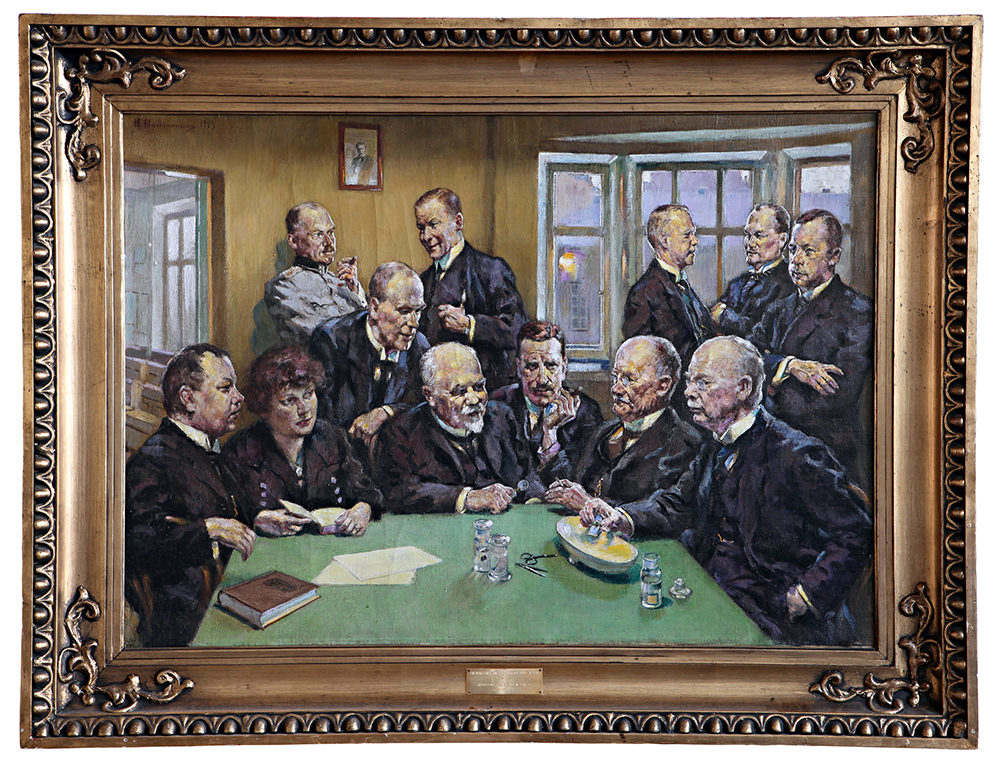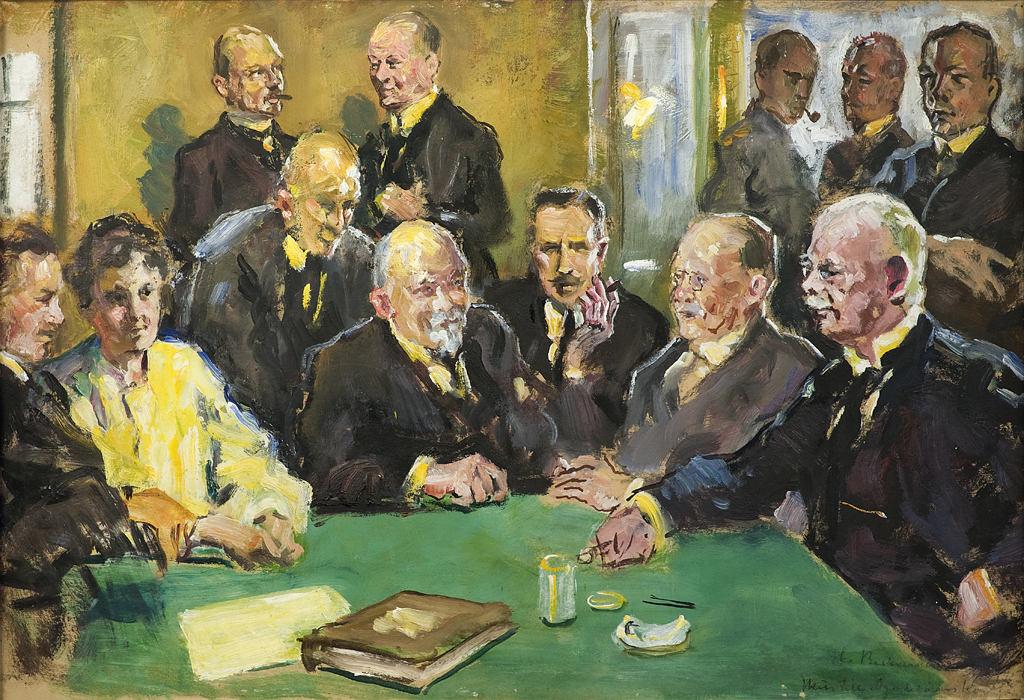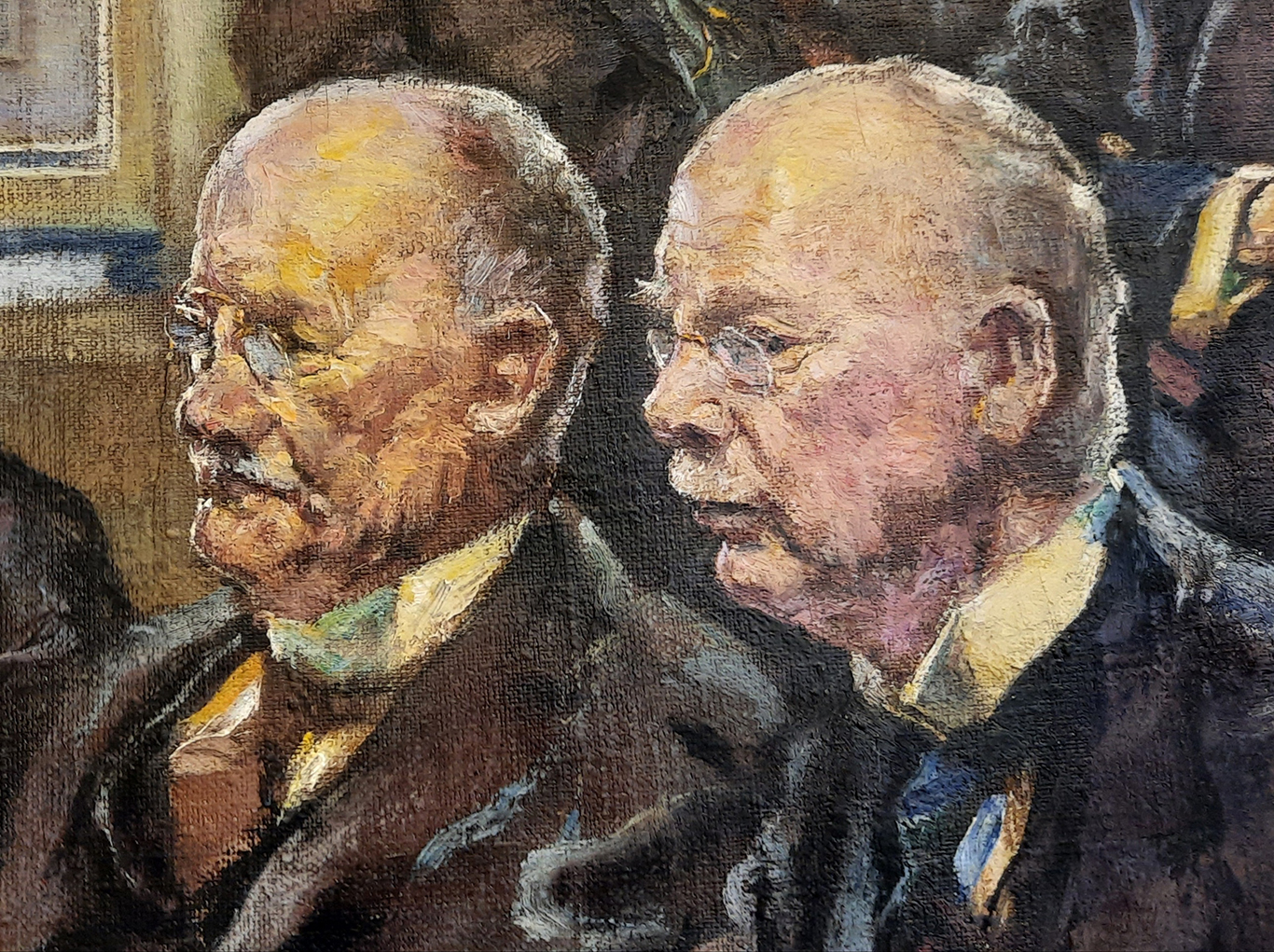February’s object of the month is Hugo Backmansson’s painting “12 Ophthalmologists” from the Galleria Academica portrait collection of the University of Helsinki. The piece hangs in the Emergency Outpatient Clinic for Eye Diseases. Located in the Meilahti medical campus, the clinic was originally affiliated with the University, but was transferred to the Helsinki University Central Hospital in 1958 and to the Hospital District of Helsinki and Uusimaa (HUS) in 2000. The Helsinki University Museum and the HUS Museum Committee performed an inventory on the historical collections of the clinic last year and divided the objects in the collection between them.
Completed in 1923, the painting, which is also known as “The meeting of ophthalmologists”, depicts a group of twelve ophthalmologists gathered around a green table. Some seem to be engaged in a lively discussion while others are lost in thought. Backmansson has rendered each character as a distinct personality without ignoring the group dynamics in the piece.

The creation of the Finnish Ophthalmological Society
The group portrait commissioned from Backmansson depicts a meeting of the Finnish Ophthalmological Society with its founding members and other influential people in the Society. From the left, the people in the painting are Arvi Wartiovaara, Finland’s first female ophthalmologist Hanna Galetski-Olin, Johan G. Lindberg, ophthalmologist at the Vyborg Deaconess Institute and the first to describe a disease often associated with glaucoma, Arthur Grunér, Emil Enroth, Karl Reinhold Wahlfors, Väinö Grönholm, Ernst Viktor Knape leaning against the yellow wall, Osmo Neovius next to him and Emil Behse by the window with Viljo Verner Alkio and Sven Brotherus. A framed photograph of Albert Nordman, the first chair of the Finnish Ophthalmological Society, hangs on the back wall.
The Finnish Ophthalmological Society was founded on 22 January 1911 and is the first specialist medical society in Finland. The founding meeting was held at the Federation of Finnish Learned Societies, which would later serve as the University’s gymnasium facility. Today, the building is home to the Museum of Finnish Architecture.
The founding meeting of the Finnish Ophthalmological Society was attended by ten people, of whom Arvi Wartiovaara, Väinö Grönholm, Ernst Viktor Knape and Osmo Neovius are also depicted in the painting. The other meeting participants were Werner Eliel Grénman, Emil Wilhelm Jusélius, Elis Gustaf Ferdinand Kuhlefelt, Gustaf Albert Nordman, Johannes Silfvast and Paul Styrbjörn Wirzenius. Artur Grunér, who originally proposed that the society be founded, and Karl Reinhold Wahlfors, extraordinary professor of ophthalmological diseases who supported Grunér’s proposal, are also considered to be among the founding members.
Backmansson’s painting has spent nearly a century on the wall of the clinic of the Eye and Ear Hospital. The original ophthalmological clinic was established in an old laundry on the backyard of the surgical clinic. Jakob August Estlander, professor of surgery, opened the department of ophthalmological diseases in 1861 and unofficially designated it as the speciality of the surgical clinic. A professorship in ophthalmology was established at the University in 1871 thanks to Frans Josef von Becker, professor of physiological chemistry and pharmacology, the first professorship in this field to be established in the Nordic countries. Von Becker first held the professorship himself. The clinic, now dubbed the Emergency Outpatient Clinic for Eye Diseases, currently operates on Haartmaninkatu, but will relocate to the new Oak Hospital building upon its expected completion in 2023–2024.
The painting was donated to the eye clinic on 17 February 1923, to celebrate the clinic’s first 50 years of operation. At the donation ceremony, Arvi Wartiovaara, who was the chair of the Society at the time, gave a speech where he described the painting as
“a work of art depicting a meeting of the Society, demonstrating love and respect for the institution under which our members completed the first years of their specialisation studies, some of them remaining there throughout their career.”
The painting was received by Väinö Grönholm, the director of the clinic. Wartiovaara and Grönholm are appropriately depicted as facing each other in the painting.
Hugo Backmansson – officer, artist, portrait painter
Hugo Backmansson (1860–1953) was both an artist and soldier by trade. He was also the first artist born in Finland to receive training as a battle painter. During his military career, Backmansson travelled widely, serving as a military painter. He received his artistic education first at the Turku Drawing School and the St Petersburg Academy of Arts, studying further in Paris and Munich. His military training was from the Hamina Cadet School and the Military Academy in St Petersburg.
Backmansson was the fifth child born into the family of tax collector Karl Backmansson and Sofia Backmansson (née Danielsson). Originally based in Paimio, the family soon moved to Turku where the young Hugo would study drawing under the tutelage of R.W. Ekman alongside his schoolwork. Due to pressure from his father, Backmansson entered the Cadet School despite not enjoying the studies. Backmansson was successful in his military career, but dreamed of becoming a full-time artist. In a letter to his sister in 1899 he wrote:
“At the moment I am making my living from portrait commissions, of which I have many. Will they be good? Well, you shouldn’t ask me, as I will get paid all the same. I could ask for a great deal of money if only I dared, but we Finns are so modest.”

During his travels as lieutenant colonel, Backmansson painted war-themed works. He had made historical war paintings before, but in 1904 he had his first experience as a battlefield painter on the front in Manchuria. Backmansson exhibited pieces he had painted in the Russo-Japanese war in Turku in late 1905 and early 1906. The exhibition included more than a hundred pieces, some of which were purchased for the collections of the Turku Art Museum.
Backmansson is also known for the works he painted in North Africa, most of them portrait studies of local people. Backmansson’s first visit to North Africa was in 1898, but he would later travel in the area again. The often colourful studies he painted on his trips were quite popular with buyers in Finland.
After settling in Helsinki, Backmansson worked as a portrait painter for many years. The collections of the University of Helsinki include three other portraits by Backmansson in addition to the group portrait of the twelve ophthalmologists. These include the portrait of Edwin Linkomies, professor of Roman literature and dean of the Department of Arts, who later became rector of the University, then chancellor, and ultimately, the prime minister of Finland (portrait from the 1930s), as well as Kaarlo Levander, professor of zoology (portrait from 1936) and Torsten Karstén, professor of Nordic philology (1938).
In addition to individual portraits, Backmansson was known for his group portraits which is why he was commissioned to paint the group of Finland’s pioneering ophthalmologists. The painting “12 ophthalmologists” was included in Backmansson’s private exhibition at the Strindberg art salon in 1924, the year following its completion.
Tutta Palin, who has written about Backmansson’s group portraits, described Backmansson as a social person who enjoyed portraiture. Typical Backmansson group portraits are paintings which depict a significant number people and have a special focus on interaction between the subjects.
Many of Backmansson’s group portraits are still known today, but one has gone missing. G.W. Wenman, general manager of Hotel Kämp, commissioned a group portrait entitled “Ilta Konstnärsklubbenissa” (‘An evening at the artists’ club’) in 1936. Backmansson was himself also a member of the club, the full title of which was the Konstnärsklubben till Albert Edelfelts minne (‘Artists’ Club in Memory of Albert Edelfelt’). It had been established at the suggestion of sculptor Ville Vallgren at the café of Hotel Kämp in 1925. Backmansson painted the piece at the Lallukka Artists’ Home, and the painting was revealed the following year. The current location of the painting is unknown. The Lallukka Artists’ Home, however, became a very familiar place for Backmansson, as he moved into the building with his family in 1933 and lived there for twenty years, until his death.
From sketch to painting
A sketch of “12 Ophthalmologists” remains in the collections of the Hiekka Art Museum.

The final composition is already apparent. The main difference to the completed piece is that Hanna Galetski-Olin, the only woman in the group, is shown wearing light colours, making her stand out, but in the final painting, she is dressed in dark colours as the rest of the group. She is among equals. Additionally, the sketch does not yet show the portrait of the Society’s chair on the back wall, and the objects on the table are arranged differently.
The sketch is rendered more roughly than the final piece, although Backmansson did employ rather broad brushstrokes to paint the completed work as well.

In conclusion
Hugo Backmansson is not among the most famous Finnish artists of his time, possibly since he did not quite fit in among other artists due to his military career. In addition, much of his work is housed in private collections. In 2010–2011, the Amos Anderson Art Museum organised an extensive exhibition of Backmansson’s work, which surely increased awareness of him among the public.
The painting “12 Ophthalmologists” is a typical Backmansson portrait, as it depicts both the interpersonal dynamics and the people as individuals. Included in the University of Helsinki’s art collections which are administered by the Helsinki University Museum, the painting will continue to hang in the Emergency Outpatient Clinic for Eye Diseases as a reminder of the history of ophthalmology until it is transferred to the new facilities of the clinic.
Anna Luhtala, Curator
Sources and further reading in Finnish:
Arkkitehtuurimuseo Senaatti-kiinteistöt. https://www.senaatti.fi/arvokiinteisto/arkkitehtuurimuseo (accessed 26 January 2021).
Backmansson, Tom; Lundström, Marie-Sofie; Palin, Tutta & Rönkkö, Maiju: Hugo Backmansson – Taiteilija, upseeri ja seikkailija. 2010. Helsinki: Kustannusosakeyhtiö Otava.
Forsius, Arno: Silmätautien erikoisalan vaiheita Suomessa 1800-luvulla. 2004. http://www.saunalahti.fi/arnoldus/sil_suo2.html (accessed 22.1.2021).
Kivelä, Tero: Sadan vuoden syke. Suomen Silmälääkäriyhdistys ry. http://www.silmalaakariyhdistys.fi/fin/yhdistys/historiaa (accessed 22.1.2021)
Ihatsu, Sanna: Meilahden sairaala-alue – rakennushistoriaselvitys. 2012. Virta-Palaste-Leinonen Arkkitehdit Oy.
Nummelin, Rolf: Backmansson, Hugo. Kansallisbiografia-verkkojulkaisu. Studia Biographica 4. Helsinki: Suomalaisen Kirjallisuuden Seura, 1997–. Julkaisun pysyvä tunniste URN:NBN:fi-fe20051410; artikkelin pysyvä tunniste http://urn.fi/urn:nbn:fi:sks-kbg-003296 (ISSN 1799-4349, verkkojulkaisu) (accessed 22.12.2020).
Paasonen, Susanna: Kesä Silmäklinikalla. 16.10.2020. Helsingin yliopistomuseo muuttaa -blogi. https://blogs.helsinki.fi/yliopistomuseo-muuttaa/2020/10/16/kesa-silmatautien-klinikalla (accessed 25.1.2021).
